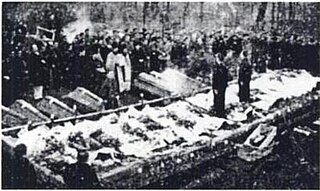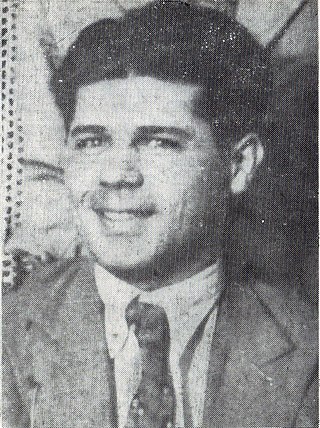
Ion Gheorghe Duca was Romanian politician and the Prime Minister of Romania from 14 November to 29 December 1933, when he was assassinated for his efforts to suppress the fascist Iron Guard movement.

The Iron Guard was a Romanian militant revolutionary fascist movement and political party founded in 1927 by Corneliu Zelea Codreanu as the Legion of the Archangel Michael or the Legionary Movement. It was strongly anti-democratic, anti-capitalist, anti-communist, and anti-Semitic. It differed from other European right-wing movements of the period due to its spiritual basis, as the Iron Guard was deeply imbued with Romanian Orthodox Christian mysticism.

Corneliu Zelea Codreanu, born Corneliu Codreanu according to his birth certificate, was a Romanian politician of the far right, the founder and charismatic leader of the Iron Guard or The Legion of the Archangel Michael, an ultranationalist and violently antisemitic organization active throughout most of the interwar period. Generally seen as the main variety of local fascism, and noted for its mystical and Romanian Orthodox-inspired revolutionary message, Iron Guard gained prominence on the Romanian political stage, coming into conflict with the political establishment and the democratic forces, and often resorting to terrorism. The Legionnaires traditionally referred to Codreanu as Căpitanul, and he held absolute authority over the organization until his death.

Armand Călinescu was a Romanian economist and politician, who served as 39th Prime Minister from March 1939 until his assassination six months later. He was a staunch opponent of the fascist Iron Guard and may have been the real power behind the throne during the dictatorship of King Carol II. He survived several assassination attempts but was finally killed by members of the Iron Guard with German assistance.

Horia Sima was a Romanian fascist politician, best known as the second and last leader of the fascist paramilitary movement known as the Iron Guard. Sima was also the Vice President of the Council of Ministers and de facto co-leader in Ion Antonescu's National Legionary State. Sima had previously served briefly as State Secretary of Education under Gheorghe Tătărescu in 1940, and as a short-lived Minister of Religion and Arts in the government of Ion Gigurtu.

Ion I. Moța was the deputy leader of the Romanian fascist Legionary Movement, killed in battle during the Spanish Civil War.

Mihai Stelescu was a Romanian political activist.

Corpul Muncitoresc Legionar or Corpul Muncitorilor Legionari was a fascist association of workers in Romania, created inside the Iron Guard and having a rigid hierarchical structure. From its creation until September 1940, the CML was led by Gheorghe Clime; afterwards, the position was filled by Dumitru Groza, who oversaw the Corps during the period when the Iron Guard was in power — the National Legionary State —, and involved it in the 1941 Rebellion and Pogrom. The CML had its headquarters in Bucharest, on Calea Călăraşilor.

During the 1930s, three notable death squads emerged from Romania's Iron Guard: the Nicadori, the Decemviri and the Răzbunători. Motivated by a combination of fascist political ideology and religious-nationalist mysticism, they carried out several high-level political assassinations in the inter-war period.
Irina Livezeanu is a Romanian-American historian. Her research interests include Eastern Europe, Eastern European Jewry, the Holocaust in Eastern Europe, and modern nationalism. Several of her publications deal with the history of Romania, Moldova, and Bessarabia. Since 1996, she is associate professor, Department of History, University of Pittsburgh. In 2010–2013 she served as president of the Society for Romanian Studies.
Greenshirts or Green shirts can mean:

The relationship between the Romanian Orthodox Church and the Iron Guard was one of ambivalence. The Romanian Orthodox Church promoted its own version of nationalism which highlighted the role of Orthodoxy in preserving the Romanian identity. Starting with the 1920s, the Church became entangled with fascist politics and antisemitism. In this context, the Iron Guard, also known as the Legion of the Archangel Michael, a fascist movement founded in 1927, became very influential with church grassroots. Numerous rank-and-file priests joined the Iron Guard ranks and actively supported its policies; so did a minority of influential high-ranking clergymen such as Nicolae Bălan or Vartolomeu Stănescu.
The Iron Guard of Egypt was a secret pro-Axis society and royalist political movement formed in Egypt in the early 1930s and used by King Farouk for personal and political vendettas. The guard was involved in attacks on Farouk's declared enemies, operating with a license to kill, and is believed to have taken orders from Farouk personally. Its other functions included protecting Farouk, serving as a special operations force, and gathering military intelligence.

Constantin "Tică" David was a Romanian communist activist and anti-fascist militant assassinated by the fascist Iron Guard during the Legionnaires' rebellion.

The Ahmadiyya is an Islamic movement in Egypt with origins in the Indian subcontinent. Although the earliest contact between Egyptians and the Ahmadiyya movement was during the lifetime of Mirza Ghulam Ahmad, its founder, the movement in Egypt was formally established in 1922 under the leadership of its second Caliph Opposition to the Ahmadiyya grew particularly in the latter part the 20th century and Ahmadis have seen increased hostility in Egypt more recently. There are up to 50,000 Ahmadi Muslims in Egypt.
Events from the year 1933 in Romania. The year saw the Grivița strikes, the formation of the Little Entente, and the assassination of the Prime Minister Ion G. Duca.

Gheorghe Clime was a Romanian fascist politician, leading member of the Iron Guard, and president of its electoral wing, Totul pentru Țară.











